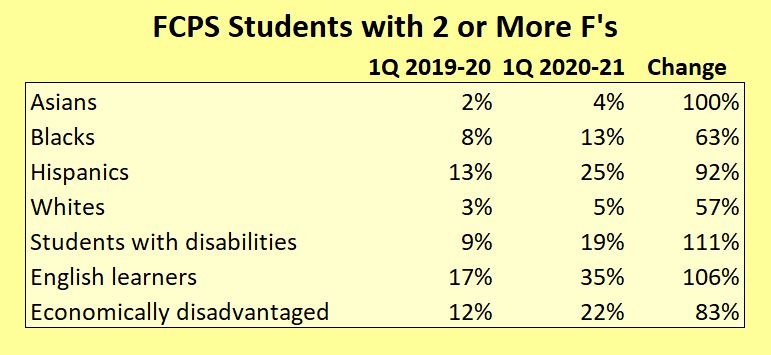Fairfax County’s decision to cope with COVID-19 by keeping kids at home to learn online is turning into a disaster for students who were struggling before the epidemic hit, especially English learners and students from economically disadvantaged families.
An internal analysis by the Fairfax County Public Schools found that the percentage of middle- and high-school students earning F’s in at least two classes jumped by 83%, from 6% to 11%. Online learning has been especially challenging for English learners, 35% of whom had two or more flunking grades. Many if not most English learners are Hispanics, 25% of whom failed in two or more classes.
The report shows that online learning accentuated performance differences that already existed. “These analyses indicated that students who performed poorly this year were those that performed poorly last year and would likely have performed poorly even without the challenges presented to them this school year,” states the report. “Those that performed well this school year were primarily those that performed well last school year.”
These findings are a predictable result of a school system that put the interests of its teachers before those of students. Teacher associations fought resumption of in-person teaching this fall for fear of the virus. The School Board capitulated, allowing only a small number of exceptionally at-risk students to resume in-person learning. Critics of the decision warned that students lacking access to broadband and laptops or living in households where parents had to work and could not supervise them would suffer the most.
As it turns out, it appears that a majority of Fairfax students have made the transition to online learning pretty well. Although Asians saw the highest percentage increase in failing students, their numbers were small to begin with. Blacks saw a comparable percentage increase — slightly lower, in fact — in failing grades as whites. The problem is concentrated among Hispanics, especially English learners.
There had been some discussion in Fairfax County about switching to a pass/fail system this year. But educators decided to stick with the traditional grading system, reports the Washington Post. The purpose was to send a message that students must take virtual school seriously. And most students did.
Fairfax County has tried to help struggling children by instituting “catch-up days” and extending the first-quarter grading period, writes the Post. The district has instructed teachers to give students no more than one hour per week of homework for each course and to provide more flexibility on deadlines. But one teacher who spoke anonymously said he is doing all those things, and it isn’t working. Many students have difficult home lives, he said. He teaches too many children to meet with all of them to investigate their home lives and plan individualized courses of study.
The Post reports that similar problems are occurring in school districts across the country, from Houston to St. Paul.
In Virginia most private schools and many public schools continue to teach in-person, though sometimes in a hybrid online/in-person arrangement. International research has shown that the spread of the virus in schools tends to be minimal, especially when mask wearing, hand washing and social distancing are enforced. Those findings are supported by Virginia Department of Health data showing only 64 “outbreaks” in K-12 schools, in which an outbreak is defined as few as two lab-confirmed cases.
Thanks to its school closings, Fairfax, the state’s largest school system, has managed to keep the number of outbreaks down to two. However, school outbreaks have created only marginally to the spread of the virus. K-12 schools across Virginia account for only 359 of Virginia’s 226,300 cases, according to VDH COVID dashboard data. More cases have been reported in child care settings than in K-12 schools.
Although the Virginia Department of Education (VDOE) is canceling some Standards of Learning exams this spring, it does plan to proceed with English and math exams. It will be interesting to compare the results of school districts that continued in-person instruction versus those, like Fairfax County, that did not. Then we’ll be able to learn how much the implementation of the lockdown mentality in Virginia schools has cost the poor, the disadvantaged, the disabled and English learners in the Age of COVID.
